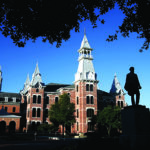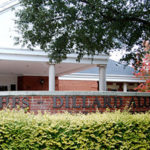WACO—The tense relationship between Baylor University and the Baylor Alumni Association may have reached a potential turning point—or boiling point—Sept. 19 when the university presented the alumni association a proposal asking the group to give up its independent nonprofit status and come under the authority of Baylor administration.
The proposal would consolidate the alumni association’s independently produced Baylor Line—which has sometimes taken positions critical of university administration and the board of regents—and the university-produced Baylor Magazine into a single publication, with the school maintaining editorial control.
In exchange, Baylor would cover operating costs for the alumni association, provide a seat on the board of regents to a member of the current Baylor Alumni Association’s board of directors, make the executive director of the alumni association vice president for alumni affairs and give the association’s current employees the option of working for the university.
Baylor Regent Bob Beauchamp presented a detailed proposal from Regent Chairman Dary Stone and Baylor University Interim President David Garland to the Baylor Alumni Associa-tion board.
Alumni association to study proposal
The association’s board passed a motion to create a study committee composed of alumni and faculty to examine the proposal.
The alumni association’s board “will strongly consider the merits of the proposal received from the board of regents and interim administration,” according to a statement by Baylor Alumni Association President David Lacy and CEO Jeff Kilgore.
The alumni association “has always given any request from the Baylor administration full consideration in keeping with the responsibilities with which it is entrusted,” the statement said.
Even so, the statement noted the request for the Baylor Alumni Association to give up its independence and become a department within the university “raises questions with many
Sign up for our weekly edition and get all our headlines in your inbox on Thursdays
alumni, considering that only two years ago, both (the alumni association) and the Baylor board of regents agreed upon and expressed their commitment to the independence of (the alumni association), strategic plans that support the mission of the university and a harmonious relationship.”
Kilgore noted the proposal from the university generated “a degree of shock” among some alumni association board members, who had anticipated their meeting would focus on events related to the association’s 150th anniversary, including the launch of a “United for Baylor” five-year plan to increase scholarship giving to children of alumni and raise money for Baylor University.
Regents emphasize national ‘best practices’
The written proposal presented to the alumni association board acknowledged “conflict of purposes” between the university and the association, and it called for the Baylor Alumni Association to become part of the school’s division of university development.
“Baylor needs a vibrant, nonpolitical, supportive alumni organization communicating with its alumni around the world,” the proposal stated.
In separate interviews, Beau-champ and Stone both characterized the proposal as an offer by the university to bring the alumni association into line with “best practices” of other major universities around the nation.
Baylor officials have insisted the number of universities with independent alumni associations is small and getting smaller, and Baylor’s relationship with its alumni association is unique among private universities.
“We must have a thriving, growing alumni association,” Beauchamp said, noting that while Baylor has graduated about 25,000 alumni in the last decade, membership in the Baylor Alumni Association has declined. In contrast, the Baylor Network—the university’s in-house alumni program—has been “thriving and growing” both in the number of events it has sponsored and the number of individuals involved, he added.
Baylor University is “carefully considering best practices in all aspects of the school,” from its governance to administration to alumni affairs, Stone added.
“Every other private school in the country” comparable to Baylor “has a well-constituted, well-organized alumni affairs effort that is a part of the school,” Stone said. The “outdated model” of an independent alumni association results in discordant messages, he noted.
“When you have two voices, two organizations, there are going to be bumps,” he said.
Different perspectives
While differences between the alumni association and the university’s administration and regents cannot be denied, Kilgore countered that the Baylor model—an independent alumni association outside the university structure—worked well as long as both parties valued each other as willing partners.
“The model in itself is not as important as how you work together,” he said.
Baylor Alumni Assoc-iation—formed 150 years ago—has functioned as an independent entity for about 30 years, when Baylor incrementally began decreasing its funding for the group by mutual consent.
But the organization’s relationship with the university has been strained for about the last seven years, when Baylor developed its own alumni services office—the Baylor Network—and began publishing its own magazine mailed to alumni and donors.
Earlier this year, the university removed the alumni association from its toll-free phone line, alumni association staff lost their university e-mail addresses, and the alumni association lost its link on the “Alumni and Friends” page of Baylor’s website.
A timeline of events distributed by Lacy and Kilgore to the Baylor Alumni Association also recounted a series of other actions demonstrating the breakdown of the relationship between the association and the university.
“For the past three years, (Baylor Alumni Association) officials have continued to request direct discussions between the board of regents and the (association’s) leadership to improve communication, including both private conversations and appearances before the full board of regents during its official meetings to address any concerns and misunderstandings,” the documents said. “To date, the board of regents has not invited (alumni association) officials to any of its official board meetings since … May 2007.”
John Barry, vice president for marketing and communications at Baylor University, said: “We take exception to a number of things in their timeline, but we are focused on the proposal that we have made and we are eager to learn of their response to it. Regardless of the inaccuracies in the timeline, what it represents is a look backward. What we are interested in, and what the Baylor family is interested in, is the future of Baylor University. That’s what the proposal represents and that’s where we want to focus.”
Kilgore insists the alumni association wants to advance the best interests of Baylor University. He noted a survey of alumni association members and non-member alumni in 2007 conducted by an independent, third-party professional researcher revealed 83 percent of the respondents believe the Baylor Alumni Association’s independence enables it to be a strong partner with the university while providing alumni their own voice.
That survey also showed 96 percent of the alumni polled believed the Baylor Alumni Association should serve as an organization that responsibly and candidly represents the values and interests of Baylor alumni, and it provides a forum for Baylor supporters to address issues regarding the wellbeing of the school, he added.
Regents and administration want to bring current leaders and supporters of the Baylor Alumni Association into the fold, not alienate them, Stone emphasized.
“We don’t want to disenfranchise one single Baylor Alumni Association leader, supporter or officer,” he said. “We want to give them a better platform within the university.”
Perceived sense of urgency
Kilgore noted the association would seek to appoint a study committee comprised of “people whose reputations in the Baylor community are beyond question.” The association will move deliberately in putting together the committee and beginning the process of study “with no preconceived notions of its outcome,” he said.
Still, he noted, some in the alumni association felt they were being pushed to accelerate the process of studying the proposal by the “media blitz” launched by the university after the meeting.
Stone denied the proposal carried any sense of urgency or deadline. He also insisted Baylor’s search for a president was “not a driver,” and the proposal was not a move to settle matters with the Baylor Alumni Association before a new university president is selected.
“There is not a timeline established. There’s no deadline. They can take as long as they need to consider the offer,” he said. At the same time, he added, “The university has to go on and conduct its business.”
Checks and balances
The document presented to the Baylor Alumni Association board said positioning the alumni association in a “watchdog role” or as the “loyal opposition” should not be the organization’s primary mission.
“It is not in the charter, nor in best practices, and not good for Baylor,” the proposal stated. “Baylor alumni as a whole do not envision the alumni association as a ‘checks and balance to the administration and the governing board of the university.’”
Baylor University’s unique history and mission created the need for the unique relationship between the school and its alumni association, the public statement by Lacy and Kilgore said.
“Baylor University is unique as an institution of higher education, maintaining a delicate balance between learning and faith while being governed by a self-perpetuating board of 21 individuals who have limited checks and balances to their authority as far as determining the future course of Baylor,” the statement said.
“Because of that special status, and for hundreds of other reasons, many alumni and the strongest supporters of Baylor have believed that the university is best served by an association that is self-governed and endowed with an independent voice—an association whose uniqueness in the world of private higher education matches the uniqueness of the institution it serves. We must carefully study whether or not this mission holds true today as we consider this new proposal.”
Proposal outlined
The document offered 12 specific proposals:
•Baylor Alumni Associa-tion would terminate its status as an independent nonprofit entity, become a unit within the Baylor structure and assume the responsibility of “involving, reaching and energizing the entire alumni base of Baylor.”
The university maintains its ability to communicate with about 120,000 out of 140,000 Baylor alumni. The Baylor Alumni Association has about 19,000 members.
•The university would provide the new Baylor Alumni Association with “appropriate resources and funding to enable its effective communication with all Baylor alumni.”
•Current employees and staff of the Baylor Alumni Association would be offered the option to become employees of the university and work within the new structure.
•The alumni association would have office space in the university-owned and maintained Hughes Dillard Alumni Center.
•The alumni association “shall coordinate all fund-raising, marketing, branding and communication efforts with the administration.”
•Consolidate the Baylor Line and Baylor Magazine, with editorial control in the hands of the university.
•Baylor regents would elect one regent in 2010 from the current Baylor Alumni Association board of directors.
•Baylor’s board of regents would amend the university’s bylaws to provide for the annual selection of an ex-officio regent from Baylor alumni, starting in 2011, to serve a one-year term.
•The alumni association may transfer its board of directors and executive committee into a new associational board of advisers that will coordinate its activities with Baylor’s administration.
•The alumni association’s executive director position would become vice president for alumni affairs and report to the vice president of development. The vice president for alumni affairs may serve on Baylor’s executive council and attend regents’ meetings, except for executive sessions of the board.
The vice president for alumni affairs would nominate qualified candidates for the board of regents from the alumni base.
•Money raised by the Baylor Alumni Association as an independent entity—after all outstanding financial obligations have been met—would become part of Baylor’s endowment, designated as an endowed scholarship fund.
•Beginning Jan. 1, 2010, the university would begin awarding recognition to distinguished alumni, and those individuals will be chosen in consultation with the new alumni association.
“If you accept our proposal, the new BAA will be well funded and will flourish,” the document presented to the alumni association board said.
The written proposal expressed the “fervent hope” of Baylor regents and administration that the alumni association would accept its offer. However, it also acknowledged the possibility the association might choose to maintain its independent status.
“If so, we will continue to assist you in maintaining your independence which is virtually unique among private university alumni associations. Baylor will likewise move forward in furthering Baylor’s efforts to engage and energize support from our outstanding alumni,” the document said.
Specific elements of the proposal are “definitely subject to further discussion,” Beau-champ said, adding, “We’re open to new ideas.”
What makes Baylor unique?
The Baylor Alumni Associ-ation seems to understand the unique character of Baylor University better than the school’s regents or administration, asserted Marie Brown of Aubrey, president of the Baylor Black Alumni Club.
“Baylor’s administration continues to promote how Baylor is different from most private institutions of higher learning. The administration also continues to promote Baylor as a Christian university that fosters unity, morality and strong Christian values in order to produce well-rounded graduates who will be prepared to accept any challenge life has to offer. However, it is evident that in the past several years, the administration as well as members of the board of regents have lost sight of Baylor’s mission and core values in their campaign to dismantle” the Baylor Alumni Association, she wrote in an opinion article submitted to several media outlets.
Baylor’s administration and regents should direct attention to problems deeper than the university’s relationship to the Baylor Alumni Association, said Brown, who serves on the alumni association’s board.
“The issues of attracting and retaining a stable administration, after a period of great turbulence in the president’s office, should be the main focus of the board of regents,” she said. “Baylor University is different than other schools, and that is why students choose to attend Baylor. However, if the board of regents as well as the interim administration continue their campaign to be in total control of the one organization that represents all alumni, then you will also lose a part of what makes the university so unique.”
Brown noted the contributions the Baylor Alumni Association has made to minority students. With the association’s assistance, the Baylor Black Alumni Club “would not have been able to award more than $15,000 in scholarships over the past nine years to deserving minority students,” or “host 11 scholarship luncheons to secure funds for its endowment,” she said.
The association also enabled the Baylor Black Alumni Club to support student initiatives such as the Association of Black Students, Baylor NAACP, Hispanic Student Association, and other student organizations, she added.
For more information, see http://www.baylor.edu/pr/news.php?action=story&story=61653 and http://www.bayloralumniassociation.com/news/news.asp?show=VIEW&a=87 .














We seek to connect God’s story and God’s people around the world. To learn more about God’s story, click here.
Send comments and feedback to Eric Black, our editor. For comments to be published, please specify “letter to the editor.” Maximum length for publication is 300 words.